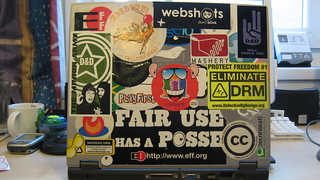Speaker: Kevin Smith, Duke University
It used to be that libraries didn’t have to care about copyright because most of our practices were approved of by copyright law. However, what we do has changed (we are not in the age of the photocopier), but the law hasn’t progressed with it.
Getting sued is a new experience for libraries. Copyright law is developed through the court system, because the lawmakers can’t keep up with the changes in technology. This is a discovery process, because we find out more about how the law will be applied in these situations.
Three suits — Georgia State e-reserves, UCLA streamed digital video, and Hathi Trust & 5 partners for distributing digital scans and plans for orphaned works. In all three cases, the same defense is being used — fair use. In the Hathi Trust case, the author’s guild has asked the judge to not allow libraries to apply fair use to what they do because the copyright law covers specific things that libraries can do, even though it explicitly says it doesn’t negate fair use as well.
Whenever we talk about copyright, we are thinking about risk. Libraries and universities deal with risk all the time. Always evaluate the risk of allowing an activity against the risk of not doing it. Fair use is no different.
Without taking risks, we also abdicate rewards. What can we gain by embracing fair use? Take a look at the ARL Code of Best Practices in Fair Use for Academic & Research Libraries (which is applicable outside of the academic library context). The principles and limitations of fair use is more of a guide than a set of rules, and the best practices help understand practical applications of those guidelines.
From the audience: No library wants to be the one that wrecked fair use for everybody. Taking this risk is not the same as more localized risk-taking, as this could lead to a precedent-setting legal case.
These cases are not necessarily binding, they are a data point, and particularly so at the trial court level. However, the damages can be huge, and much more than many other legal risks we take. Luckily, in these cases, you are only liable for the actual damages, which are usually quite small.
The key question for fair use has been, “is the use transformative?” This is not what the law asks, but it came about because of an influential law review article by a judge who said this is the question he asked himself when evaluating copyright cases. The other consideration is whether the works are competitive in the market, but transformative trumps this.
When is a work derivative and when is it transformative? Derivative works are under the auspices of the copyright holder, but transformative works are considered fair use.
In the “Pretty Women” case, the judges said that multiple copies for educational purposes is a classic example of fair use. This is what the Georgia State judge cited in her ruling, even though she did not think that the e-reserves were transformative.
Best practices are not the same as negotiated guidelines. These are a broad consensus on how librarians can think about fair use in practice in an educational setting. Using the code of best practices is not a guaranteed that you will not get sued. It’s a template for thinking about particular activities.
In the Hathi Trust case, the National Federation for the Blind has asked to be added as a defendant because they see the services for their constituents being challenged if libraries cannot apply fair use to their activities that bring content to users in the format they need. In this case the benefit is great and the risk is small. Few will bring a lawsuit because the library has made copies so that the blind can use a text-to-speech program. Which lawsuit would you rather defend — for providing access or because you haven’t provided access?
Fair use can facilitate text-mining that is for research purposes, not commercial. For example, looking at how concepts are addressed/discussed across a large body of work and time. Fair use is more efficient in this kind of transformative activity.
What about incorporating previously published content in new content that will be deposited into an institutional repository? Fair use allows adaptation, particularly as technologies change. This is the heart of transformative use — quoting someone else’s work — and should be no different from using a graph or chart. However, you are using the entirety of the work, and should consider if the amount used is appropriate (not excessive) for the new work.
What about incorporating music into video projects? If the music or the video is a fundamental part of the argument and help tell the story, then it’s fair use. If you don’t need that particular song, or it’s just a pretty soundtrack, then go find something that is licensed for you to use (Creative Commons).
One area to be concerned with, though, is the fair use of distributing content for educational purposes. Course packs created by commercial entities is not fair use. Electronic course readings have not been judged in the same way because the people making the electronic copies were educators in a non-commercial setting. Markets matter — not having a market for these kinds of things helped in the GSU case.
The licensing market for streaming digital is more “hit or miss,” and education has a long precedent for using excerpts. It’s uncertain if an entirety of a work would be considered fair use or not.
Orphan works is a classic market failure, and has the best chance of being supported by fair use.
Solutions:
- Stop giving up copyright in scholarly works.
- Help universities develop new promotion & tenure policies.
- Use Creative Commons licenses.
- Publish in open access venues or retain rights and self-archive.

